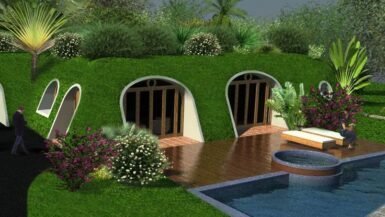In today’s rapidly evolving world, the concept of sustainable living has gained significant traction, as more and more individuals are seeking ways to minimize their ecological footprint. One such approach that has emerged as a viable and environmentally-friendly solution is the adoption of tiny homes. This article delves into the numerous benefits of downsizing and highlights why tiny homes are poised to become the cornerstone of sustainable living in the future. We will explore the financial, environmental, and lifestyle advantages that tiny homes offer, as well as discuss the role they play in promoting a more mindful and efficient way of life. Join us as we unfold the reasons why choosing a tiny home could be the key to unlocking a greener and more fulfilling existence.
Energy Efficiency: Lowering Carbon Footprint with Tiny Homes
As we venture into a world where the consequences of climate change are becoming increasingly apparent, it is essential for individuals to take responsibility for their carbon footprint. One of the most effective and accessible ways to reduce our environmental impact is through our choice of living space. Tiny homes, with their minimalist design and emphasis on energy efficiency, are a powerful solution for those looking to minimize their ecological impact.
Reduced Energy Consumption
One of the most significant advantages of tiny homes is their reduced energy consumption. Due to their smaller size, these homes require less energy to heat, cool, and light, resulting in lower utility bills and a smaller carbon footprint. Additionally, as tiny homes are often designed with energy efficiency in mind, they frequently incorporate features such as solar panels, high-quality insulation, and energy-efficient appliances, further reducing their reliance on non-renewable energy sources.
Less Construction Waste
Tiny homes require fewer materials to build, which means that the construction process generates less waste. Traditional homes often result in significant amounts of construction waste, which ends up in landfills and contributes to environmental degradation. By opting for a smaller living space, individuals can drastically reduce the amount of waste generated during construction and contribute to a more sustainable future.
Smaller Land Footprint
The land footprint of a tiny home is significantly smaller than that of a traditional house, which means that the environmental impact of land clearing and construction is minimized. This reduction in land usage allows for the preservation of green spaces and natural habitats, contributing to greater biodiversity and a healthier ecosystem.
Encouraging Sustainable Living Practices
Living in a tiny home naturally encourages individuals to adopt more sustainable lifestyle habits. With limited space, there is a greater emphasis on mindful consumption, as every item brought into the home must have a purpose and a place. This way, residents are more likely to prioritize quality over quantity and opt for durable, eco-friendly products. Additionally, tiny home dwellers often build strong connections with their local community, fostering a sense of shared responsibility for the environment and encouraging collective action towards sustainable living.
Embracing the tiny home lifestyle represents a powerful opportunity for individuals to take control of their carbon footprint and contribute to a more sustainable future. By reducing energy consumption, generating less waste, and promoting mindful living practices, tiny homes offer a practical and accessible solution for those seeking to make a positive impact on the environment.
Minimalism and Mindfulness: Embracing Simplicity in Tiny Living Spaces
As the world becomes increasingly focused on consumerism and material possessions, the philosophy of minimalism offers a refreshing alternative. At its core, minimalism is about embracing simplicity and prioritizing the things that truly matter in life. This way of thinking is perfectly aligned with the tiny home movement, which advocates for a more mindful and intentional approach to living. In this section, we will delve into the numerous benefits of minimalism and mindfulness in tiny living spaces, and explore how they can improve our overall well-being and satisfaction.
The Power of Less: Reducing Stress and Increasing Focus
One of the key advantages of minimalist living is the reduction of stress and clutter in our lives. By embracing a smaller living space and limiting the number of belongings we accumulate, we can create a more serene and peaceful environment in which to live. This decluttered space promotes better focus and mental clarity, allowing us to concentrate on the things that truly matter in life, such as our relationships, passions, and personal growth.
Intentional Living: Boosting Happiness and Life Satisfaction
Adopting a minimalist and mindful lifestyle encourages us to live more intentionally, making conscious decisions about how we spend our time, energy, and resources. This approach to living can have a profound impact on our happiness and life satisfaction, as it enables us to focus on our values and prioritize experiences over material possessions. By choosing to live in a tiny home, we are making a deliberate decision to live a more simplified, intentional life, which can lead to greater fulfillment and contentment.
Financial Freedom: Reducing Expenses and Building Wealth
The financial benefits of downsizing to a tiny home are significant, as it often results in reduced housing costs, lower utility bills, and decreased expenses related to maintenance and upkeep. This reduction in expenses allows individuals to allocate their resources towards other priorities, such as paying off debt, building an emergency fund, or investing in experiences and personal growth. In turn, this financial freedom can lead to reduced stress and a greater sense of control over one’s life.
Environmental Stewardship: Cultivating a Deep Connection with Nature
Living in a tiny home often goes hand-in-hand with a deep appreciation for the natural world. By embracing a minimalist lifestyle, we are more likely to develop a stronger connection with our environment and prioritize its preservation. This connection can inspire us to make eco-conscious choices, such as opting for sustainable materials, reducing waste, and conserving resources. Consequently, our commitment to minimalism and mindfulness can have a positive ripple effect on the environment and contribute to a more sustainable world.
Ultimately, the practice of minimalism and mindfulness in tiny living spaces allows us to break free from the trappings of consumerism and focus on what truly matters in life. By reducing stress and clutter, cultivating intentionality, achieving financial freedom, and fostering a connection with the environment, we can unlock a more fulfilling, purpose-driven existence. The tiny home movement is not just about downsizing our living spaces, but also about embracing a more mindful, sustainable, and satisfying way of life.
Sustainable Materials: Eco-friendly Building Techniques for Tiny Homes
The increasing popularity of tiny homes has led to a surge in innovative and eco-friendly building techniques. These methods prioritize the use of sustainable materials and construction practices, ensuring that tiny homes not only have a minimal ecological footprint but also contribute positively to the environment. In this section, we will explore various eco-friendly building techniques employed in the tiny home movement, highlighting the benefits of each and showcasing their potential to revolutionize sustainable living.
Reclaimed and Recycled Materials: Giving New Life to Old Resources
One of the most effective ways to minimize the environmental impact of constructing a tiny home is by using reclaimed and recycled materials. This approach involves repurposing previously used materials, such as wood, metal, and glass, and incorporating them into the construction of a new home. By doing so, tiny home builders can reduce the demand for new resources, decrease waste, and preserve the character and charm of the original materials.
Green Insulation: Energy-efficient Solutions for a Cozy Home
Proper insulation is crucial for maintaining a comfortable living environment in a tiny home, and eco-friendly insulation options can further enhance the sustainability of the structure. Materials such as sheep’s wool, recycled denim, and cellulose insulation made from recycled paper products offer excellent thermal performance and a reduced environmental impact compared to conventional insulation materials. These green alternatives not only contribute to energy efficiency but also promote healthier indoor air quality.
Non-toxic Building Materials: Prioritizing Health and Well-being
Incorporating non-toxic building materials is another essential aspect of sustainable tiny home construction. Many traditional building materials emit harmful chemicals and volatile organic compounds (VOCs), which can have negative effects on the health of the occupants. By using low-VOC paints, sealants, and adhesives, as well as natural materials like straw bales, clay, and lime plaster, tiny home builders can create a healthier living space and reduce the overall environmental impact of their homes.
Solar Power and Rainwater Harvesting: Harnessing Nature’s Gifts
Embracing renewable energy sources and sustainable water management systems is a key aspect of eco-friendly tiny home design. By incorporating solar panels, tiny homes can generate clean, renewable energy to power their electrical needs, reducing both their carbon footprint and utility costs. Additionally, rainwater harvesting systems can be integrated into the design, capturing and storing rainwater for use in irrigation, toilet flushing, or even as a primary water source after proper treatment.
Passive Design Principles: Maximizing Efficiency and Comfort
Passive design principles are a set of strategies used to create a more energy-efficient and comfortable living environment without relying on mechanical systems. These principles include optimizing the home’s orientation, window placement, and building materials to take advantage of natural light, ventilation, and thermal mass. Implementing passive design techniques in a tiny home can significantly reduce energy consumption, lower utility bills, and contribute to a healthier, more comfortable living space.
By utilizing sustainable materials and eco-friendly building techniques, tiny homes can offer a viable solution for those seeking to minimize their environmental impact and embrace a more sustainable lifestyle. From reclaimed materials and green insulation to solar power and passive design principles, the tiny home movement showcases the potential for innovative, environmentally responsible construction methods to shape the future of sustainable living.
Reducing Waste: Tiny Homes’ Impact on Landfills and Resource Consumption
As our world grapples with the escalating issue of waste management, adopting sustainable practices to minimize waste generation is becoming increasingly crucial. Tiny homes offer a viable solution to this pressing concern, as they significantly reduce resource consumption and minimize the amount of waste that ends up in landfills. In this subsection, we will delve into the various ways in which tiny homes help to alleviate the burden on our planet’s resources and waste management systems, highlighting their potential to revolutionize the future of sustainable living.
Less Raw Materials: Minimizing the Strain on Natural Resources
One of the most apparent benefits of tiny homes is their reduced demand for raw materials during construction. As these homes occupy a smaller footprint, fewer resources such as wood, metal, and concrete are required for their construction. This not only conserves valuable natural resources but also decreases the energy consumption and pollution associated with the extraction, processing, and transportation of these materials.
Resourceful Design: Maximizing Space and Efficiency
Tiny homes are meticulously designed to make the most of every square foot, resulting in highly efficient spaces that minimize waste. This resourceful approach to design often involves multi-functional furniture, clever storage solutions, and innovative layouts that reduce the need for additional materials and resources. By maximizing space and efficiency, tiny homes help to curb our consumption habits and promote a more mindful, sustainable way of living.
Waste Reduction during Construction: Limiting Landfill Contributions
Another significant advantage of tiny homes is the reduced amount of construction waste generated during the building process. As these homes require fewer materials, there is a corresponding decrease in the volume of waste produced. This not only limits the amount of refuse that ends up in landfills but also reduces the greenhouse gas emissions associated with waste transportation and decomposition. By embracing the tiny home lifestyle, individuals can play an active role in reducing the environmental impact of construction and waste management.
Long-lasting Materials and Durability: Reducing Maintenance Waste
Many tiny homes are constructed using high-quality, long-lasting materials that require little maintenance and have a minimal environmental impact. By prioritizing durability and longevity, these homes not only require fewer resources for upkeep but also generate less waste over time. The focus on quality and sustainability in tiny home construction contributes to a more responsible approach towards resource consumption and waste reduction.
Conscious Consumption: Encouraging Mindful Living
Living in a tiny home fosters a heightened awareness of our consumption habits and encourages us to be more mindful of the resources we use. With limited space, residents are more likely to prioritize essential items and avoid excessive consumption. This conscious approach to living not only reduces the amount of waste generated on a day-to-day basis but also promotes a more sustainable lifestyle that values quality over quantity.
Ultimately, the adoption of tiny homes as a means of sustainable living presents a powerful opportunity to minimize waste and promote responsible resource consumption. By conserving raw materials, maximizing space and efficiency, reducing construction waste, utilizing durable materials, and fostering conscious consumption habits, tiny homes have the potential to transform the way we approach waste management and contribute to a more sustainable future.
Community Living: How Tiny Home Villages Promote Social Sustainability
As the tiny home movement continues to gain momentum, the concept of tiny home villages has emerged as an innovative way to foster social sustainability and foster a sense of community among residents. These villages, which typically consist of a cluster of tiny homes situated around shared amenities and communal spaces, offer a unique living experience that promotes social interaction, collaboration, and mutual support. In this section, we will explore the various ways in which tiny home villages contribute to social sustainability and highlight the benefits of embracing this communal approach to living.
Shared Spaces and Amenities: Encouraging Social Interaction
One of the defining features of tiny home villages is the presence of shared spaces and amenities, such as gardens, playgrounds, and communal kitchens. These shared areas provide residents with the opportunity to interact and engage with one another, fostering a sense of belonging and camaraderie. This emphasis on social interaction is particularly beneficial in today’s increasingly isolated society, as it combats loneliness and promotes strong social connections, which are essential for overall well-being.
Collective Decision-Making: Empowering Residents and Building Trust
Tiny home villages often operate on a model of collective decision-making, wherein residents work together to make decisions about the management and maintenance of their community. This collaborative approach empowers residents to take ownership of their living environment and fosters a sense of responsibility and accountability. By participating in collective decision-making, residents build trust and strengthen relationships with their neighbors, ultimately contributing to a more cohesive and resilient community.
Resource Sharing: Reducing Consumption and Fostering Collaboration
Living in a tiny home village encourages residents to share resources and collaborate on projects, which can lead to reduced consumption and waste. By pooling resources, such as tools, appliances, and vehicles, villagers can minimize their individual ecological footprints and contribute to the overall sustainability of their community. This collaborative mindset promotes a more responsible approach to consumption, as residents are more likely to prioritize quality and durability over quantity and disposability.
Intergenerational Living: Fostering Social Inclusion and Mutual Support
Tiny home villages offer the potential for intergenerational living, as they can accommodate residents of varying ages, abilities, and life stages. This diversity creates opportunities for social inclusion, mentorship, and mutual support, as residents can share their skills and knowledge with one another. Intergenerational living also contributes to social sustainability, as it fosters a sense of empathy, understanding, and respect among community members, ultimately promoting a more harmonious and supportive living environment.
Community Engagement: Cultivating a Sense of Purpose and Belonging
By living in a tiny home village, residents have the opportunity to actively engage with their local community and contribute to its well-being. This engagement can take the form of volunteering, participating in local events, or advocating for sustainable initiatives. By actively participating in their community, tiny home residents can cultivate a sense of purpose and belonging, which contributes to their overall happiness and satisfaction.
In summary, tiny home villages have the potential to revolutionize the way we approach sustainable living, particularly in terms of social sustainability. By fostering social interaction, promoting collective decision-making, encouraging resource sharing, supporting intergenerational living, and facilitating community engagement, these villages offer an innovative solution for those seeking a more connected, collaborative, and environmentally responsible way of life. Embracing the tiny home village lifestyle is not only a step towards a more sustainable future but also a powerful means of building strong, resilient communities rooted in empathy, cooperation, and mutual support.





Leave a reply